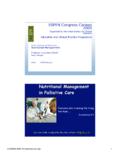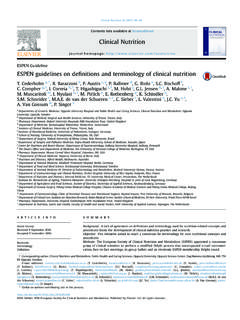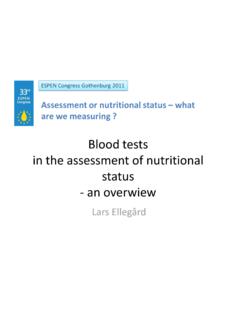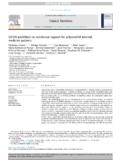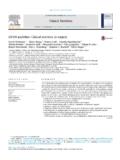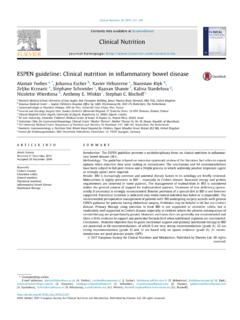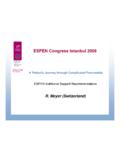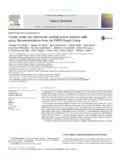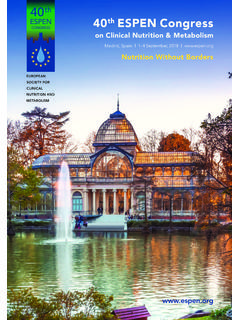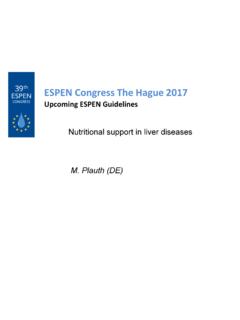Transcription of ESPEN-ESPGHAN-ECFS guidelines on nutrition …
1 E-SPEN guidelineESPEN- espghan - ecfs guidelines on nutrition care for infants,children, and adults with cysticfibrosisDominique Turcka, Christian P. Braeggerb, Carla Colomboc, Dimitri Declercqd,Alison Mortone, Ruzha Panchevaf, Eddy Robberechtg, Martin Sternh, Birgitta Strandviki,Sue Wolfej, Stephane M. Schneiderk,1, Michael Wilschanskil,*,1aUniv. Lille, Inserm U995, LIRICeLille Inflammation Research International Center, Division of Gastroenterology, Hepatology and nutrition , and CysticFibrosis Center, Department of Pediatrics, CHU Lille, F-59000 Lille, FrancebDivision of Gastroenterology and nutrition and Children's Research Center, University Children's Hospital Zurich, Steinwiesstrasse 75, CH-8032, 10 Zurich,SwitzerlandcFondazione IRCCS Ca' Granda, Ospedale Maggiore Policlinico (IRCCS)
2 , Universit a degli Studi di Milano, Milan, ItalydDepartment of Pediatrics, CF Centre, Ghent University Hospital, De Pintelaan 185, 9000 Gent, BelgiumeRegional Adult CF Unit, St. James' University Hospital, Beckett Street, Leeds, LS9 7TF, UKfDepartment of Hygiene, Faculty of Public Health, Prof. Dr. Paraskev Stoyanov Medical University of Varna, 55 Marin Drinov Str., 9002 Varna, BulgariagPediatric Gastroenterology, Hepatology& nutrition , University Ghent, CF Centre Ghent, Princess Elisabeth Pediatric Hospital, B 9000 Ghent, BelgiumhUniversity Children's Hospital, University of T bingen, Hoppe-Seyler-Strasse 1, 72076, T bingen, GermanyiDepartment of Bioscience and nutrition , Karolinska Institutet, Novum, H alsov agen 7-9, 14183 Huddinge, Stockholm, SwedenjRegional Pediatric CF Unit, The Leeds Children's Hospital, Belmont Grove, Leeds, LS2 9NS, UKkGastroenterology and Clinical nutrition .
3 Archet University Hospital and University of Nice Sophia-Antipolis, Nice, FrancelPediatric Gastroenterology, Hadassah-Hebrew University Medical Center, PO Box 24035 Jerusalem, 91240, Israelarticle infoArticle history:Received 11 January 2016 Accepted 5 March 2016 Keywords:CysticfibrosisESPEN guidelinesMalnutritionNutritional assessmentNutritional supportsummaryBackground:Malnutrition is both a frequent feature and a comorbidity of cysticfibrosis (CF), withnutritional status strongly associated with pulmonary function and survival. Nutritional management istherefore standard of care in CF patients.
4 espen , espghan and ecfs recommended guidelines to covernutritional management of patients with :The guidelines were developed by an international multidisciplinary working group inaccordance with officially accepted standards. The GRADE system was used for determining grades ofevidence and strength of recommendation. Statements were discussed, submitted to Delphi rounds,reviewed by espghan and ecfs and accepted in an online survey among espen :The Working Group recommends that initiation of nutritional management should begin asearly as possible after diagnosis, with subsequent regular follow up and patient/family breast feeding is recommended but if not possible a regular formula is to be used.
5 Energyintake should be adapted to achieve normal weight and height for age. When indicated, pancreaticenzyme and fat soluble vitamin treatment should be introduced early and monitored sufficient patients should have an annual assessment including fecal pancreatic elastasemeasurement. Sodium supplementation is recommended and a urinary sodium:creatinine ratio shouldbe measured, corresponding to the fractional excretion of sodium. If iron deficiency is suspected, theunderlying inflammation should be addressed. Glucose tolerance testing should be introduced at 10years of age.
6 Bone mineral density examination should be performed from age 8e10 years. Oral nutri-tional supplements followed by polymeric enteral tube feeding are recommended when growth ornutritional status is impaired. Zinc supplementation may be considered according to the clinical situa-tion. Further studies are required before essential fatty acids, anti-osteoporotic agents, growth hormone,appetite stimulants and probiotics can be recommended.*Corresponding author. Pediatric Gastroenterology, Hadassah-Hebrew University Medical Center, PO Box 24035 Jerusalem, 91240, Israel.
7 Tel.: 972 2 5845039; fax: 972 Wilschanski).1 These authors contributed equally to this lists available atScienceDirectClinical Nutritionjournal homepage: 2016 Elsevier Ltd and European Society for Clinical nutrition and Metabolism. All rights nutrition xxx (2016) 1e21 Please cite this article in press as: Turck D, et al., ESPEN-ESPGHAN-ECFS guidelines on nutrition care for infants, children, and adults with cysticfibrosis, Clinical nutrition (2016), :Nutritional care and support should be an integral part of management of CF. Obtaining anormal growth pattern in children and maintaining an adequate nutritional status in adults are majorgoals of multidisciplinary cysticfibrosis centers.
8 2016 Elsevier Ltd and European Society for Clinical nutrition and Metabolism. All rights Development of guidelines for cysticfibrosis nutrition careThe European Society for Clinical nutrition and Metabolism( espen ) launched a process of developing updated guidelines onnutrition care for infants, children, and adults with cysticfibrosis(CF). The group included physicians, dietitians, and educators, allexperts in thefield of cysticfibrosis, as well as the guidelinescoordinator (SMS); all are authors of this guideline Cochrane reviews have highlighted a lack of randomizedcontrolled trials examining the effects of nutritional interventionsin patients with CF[1e8].
9 Consistent with thesefindings, many ofour nutrition guidelines are based on consensus expert opinions[9e11]. The experts followed the GRADE method, which was basedon determinations ofgrade of evidenceandstrength of recommen-dation; the methodology is described elsewhere[12]. A meetingwas organized in Stockholm, Sweden, in April of 2012. These newguidelines are meant to update the 2002 European consensusguidelines on nutrition for people with cysticfibrosis[11].Literature search was conducted in the PubMed and Cochranedatabases until 2014, using the following terms: cysticfibrosis AND( nutrition * OR diet* OR nourishment OR nutrient OR nutriment ORmalnutrition OR malnourishment OR undernourishment OR calo-rie* OR lipid* OR trace OR vitamin* OR protein* OR taurine ORpancreatic enzyme replacement therapy OR PERT OR fatty ORmicronutrient* OR antioxidant* OR probiotic* OR supplement* ORinsulin OR enteral OR parenteral OR EN OR TPN OR PN).
10 Thegrade of evidencewas determined by a number of factors,starting with the number and type of research studies[13e17].Grading fromHightoVery Lowwas used to rate the quality of theunderlying evidence and the level of certainty for effect (Table 1)[15]. Highest quality evidence resulted from consistent results inmeta-analysis of multiple randomized controlled trials, with thenext highest level defined by at least one well-designed random-ized controlled trial. Moderate and low-level evidence came fromcontrolled trials that were not randomized, from cohort- or case-controlled studies, or from multiple time series trials.
